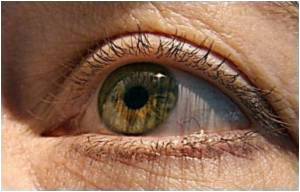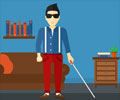
This software was developed by a group coordinated by Rosario González Anera, receiving technical support of the Granadian company Seven Solutions and of an ophthalmological clinic set in Madrid and named Novovision. The research group was integrated by researchers José Juan Castro, Carolina Ortiz and Aixa Alarcón, and receives fundings from the regional government of Economy, Innovation and Science of the Junta de Andalucía.
Low-Light ConditionsBefore the test, researchers fix the observer's position with a chin cup and a forehead holder at an adequate distance from the monitor where the test will be displayed and considering the angular diameter that light stimuli must have. The test is performed under low-light conditions (in a dark room) and, before the test, patients are given some minutes to adapt to darkness.
This test involves showing a bright light stimulus to the subject against a dark background and, progessively showing different peripheral light stimuli –with lower brightness around the central (Figure 2), at random, in different positions and at different distances. Subjects' task is to press the buttom of a mouse every time they detect a peripheral stimulus. Once the test ends, the software makes an estimation of a parameter named "Visual Disturbance Index" that, together with the results graphic, determines the type and intensity of visual disturbance.
This index scores from 0 to 1, so the higher is this index, the stronger is the influence of the halo or any other visual disturbance perceived by the observer. Therefore, the lower is the subject's ability to detect the peripheral stimuli displayed around the main stimulus that causes such disturbances.
One of the advantages of the halometer developed at the University of Granada is that it allows to configure such test parameters as:
Advertisement
- Special parameters: the radius of the central stimulus and the peripheral stimuli can be modified. Furthermore, the number of semi-major axes where the peripheral stimuli will be displayed can be fixed, as well as the maximum radius –maximum distance between these stimuli-, and the number of stimuli per semi-major axe.
- Temporary Parameters: the software allows to set some exposure time for adaptation to darkness and to the brightness of the central stimulus. Furthermore, others parameters as the exposure time to the stimulus and the time elapsed between a stimulus and the next one can also be set. Advertisement
- The software also allows to set the color and brightness of central and peripheral stimuli, and the weight and number of times each peripheral stimulus is shown.
The results obtained with this halometer and the new software have been presented in different national and internacional conferences as the IX Reunión Nacional de Óptica, Galice and the Wavefront Confress 2009. furthermore, a research article has been published in the international journal Applied Optics describing the results obtained with patients operated with refractory eye surgery. It has also been recently admitted for publication in the prestigious scientific journal Journal of Biomedical Optics, where the results obtained with patients with different eye pathologies are described.
Source-Eurekalert











